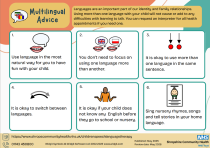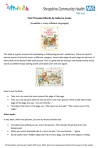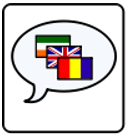
What is it?
A child, young person or adult is bilingual (or multilingual) if they can use and/or understand two or more languages. Bilingualism is also known as EAL (English as an Additional Language) where English is the main language of the wider community.
The languages may be:
· Spoken languages
· Sign languages
· Or a combination of spoken and sign languages.
Bilingualism is seen as an advantage rather than a disadvantage in many ways.
A bilingual child is just as likely as a monolingual child to have a speech, language, communication or feeding and swallowing disorder. Being bilingual does not cause or contribute to any speech, language, communication or feeding and swallowing disorders.
The skills of a bilingual child in each language may not be equal and it is normal to use different languages in different situations, for example, one language in school and another at home. However, if a child has difficulty in both, or all, of their languages this is likely to be a speech and/or language disorder or delay.
Speech and Language Therapy can be very helpful for bilingual children with a speech, language or communication disorder:
· It is possible to carry out assessment and deliver effective and supportive care in the home language and professional interpreters play a role in making this possible.
· There is a wide range of information about other languages available, including resources for speech and language therapy in other languages.
Where there is no speech, language or communication disorder it is the job of the nursery or school to support a bilingual child’s language development in English.
What to look for.
My child has stopped talking. Don’t worry, this is a normal stage when learning a second language. It this lasts longer than one month then there may be a problem, but the silent phase can last 6 months to a year even in the absence of additional difficulties. Your child is still learning language so keep talking to them in your home language.
My child mixes both languages. Don’t worry, this is common in bilingualism They may say one sentence in one language and the next in another. They may also change between languages within a sentence. It is not a sign of your child being confused but a sign of developing competency in using language. If your child does not mix languages and they are having difficulties in both or all languages, they may have Developmental Language Disorder (DLD).
My child makes speech sound errors in both languages. A child with a speech sound disorder or delay may make similar but not identical speech sound errors in both or all languages. An assessment in both or all languages is recommended.
My child seems to be losing the home language. Keep using the home language with your child. Language loss can happen very quickly if the home language stops being used. It may then be difficult for the child to regain their skills in the home language due to lack of exposure and use.
Top Tips.
Do..
- Do keep using your home language with your child. Being bilingual will not confuse your child. Being bilingual will not negatively affect your child’s development. Research shows that being bilingual is an advantage.
- Do use the language you know best as this is the best language model you can provide. This will help your child learn other languages.
- Do use a professional interpreter rather than to try to ‘get by’ in English or use friends, relatives, or other children in the family.
- Do let the service know the correct language and dialect (variant of language) you speak at home so that we can find the most suitable interpreter to support us in helping your child.
- Do place value on your home language. It is an important part of your family identity and culture. Losing a language can have a negative impact on identity and heritage culture, as well as parent-child bonding.
- Do use games, movies, TV programmes, music and books in the home language and English.
- Do ask your Speech and Language Therapist if assessment and treatment is needed in the home language and in English. Treatment should ideally be carried out in the home language before treatment in English
Do not..
- Do not stop using your home language. Language can be lost very quickly if a child is no longer exposed to it.
- Do not stop switching between languages within a sentence or from one sentence to the next if this is natural for you. This will not confuse your child.
- Do not stop your child switching between languages either. This is not a sign of confusion. Instead it is a sign of developing competence in language.
More Links and Leaflets

The advice and recommendations on this webpage are also available on this leaflet.
The Time Together booklet for Parents, from the National Literacy Trust, comes in 22 different languages. It is full of suggestions for how parents can support their young child's learning at home, including language development. (You will need to sign up to the National Literacy Trust to access this document. You can select the free option to access it.

The free walk and talk trail, produced by the National Literacy Trust, is a set of cards designed to support parents and carers of 0 to 5-year-olds to talk and play more with their children while they are out and about engaging in their daily routine. The cards are available to download in the following languages; Albanian, Arabic, Bengali, Chinese, Czech, Polish, Portuguese, Romanian, Slovak, Spanish, Ukrainian, Urdu.

Books are a great way to discover new words. This leaflet suggests possible activities to do with a book. The suggested book, in this leaflet, is available in 13 different languages.


